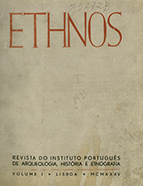

................................
The periodical’s evolution can be divided into three phases: The initial phase (1935–1948), marked by the influence of Leite de Vasconcelos (the 1948 issue even includes a photograph of a sculpture of the archaeologist by Raúl Xavier, dated 1934). The resurgence phase (1965–1970), under the leadership of Manuel Heleno. The epilogue (1979), characterised by the journal's loss of purpose.
While the majority of contributors were Portuguese-speaking (mainly Portuguese, with some Brazilians), the journal also featured work by English-, Spanish-, German-, French-, and Polish-speaking authors. Notably, the Polish author wrote in Portuguese, as he was based in Portugal. The first (1935) and last (1979) issues showcased the most international contributions, whereas the intermediate editions predominantly featured Spanish- and French-speaking authors. Foreign contributors included Georges Zbyszewski, Thomas Bubner, Charles Boxer, Georg Otto Schurhammer, Juan Llabrés Bernal, Georg Leisner, A. R. Nykl, Gastão Bettencourt, and Jean Ollivier. Prominent Portuguese authors included Serafim Leite, Rocha Madahil, Silva Marques, José Hermano Saraiva, Hernâni Barcos, Saavedra Machado, João Afonso Corte-Real, Fernando Castelo Branco, Margarida Ribeiro, Eduardo Prescott Vicente, Vítor Serrão, Jorge de Alarcão, and Eduíno Borges Garcia.
The eight issues collectively contained 147 articles, distributed across the following themes: Archaeology: 59 articles; History: 43 articles; Ethnography: 28 articles; Philology: 6 articles; Art History: 5 articles; Memorials: 4 articles; Literature: 1 article; Historical Methodology: 1 article In terms of thematic evolution, History dominated the inaugural issue in 1935 and remained consistently represented with at least five articles per issue, except for 1966, 1970, and 1979, which featured only one. Archaeology, after a modest start with two articles, eventually surpassed History in prominence, except in 1965 and 1969. The 1979 issue saw the most significant disparity, with seven articles on Archaeology compared to one on History. Ethnography followed a similar trajectory to Archaeology, growing substantially after its modest debut in the inaugural issue. Memorials were occasional, focusing on figures significant to the journal's scientific domains and often intended to consolidate resources for academic work. Literature and Historical Methodology each appeared only once, while Philology featured six articles (three in 1935, with the last in 1969). Art History maintained a modest but consistent presence throughout the periodical’s run. As a result, approximately 88 percent of the journal's total scientific output was dedicated to Archaeology, History, and Ethnography, with the remaining 12 percent focused on Philology, Art History, Literature, Historical Methodology, and Memorials. This distribution aligns closely with the core thematic areas of the institute from which the journal emerged.
This work is financed by national funds through FCT - Foundation for Science and Technology, I.P, in the scope of the projects UIDB/04311/2020 and UIDP/04311/2020.
